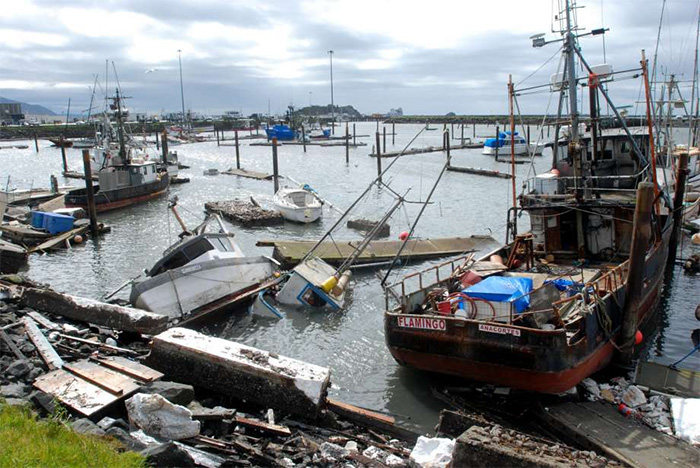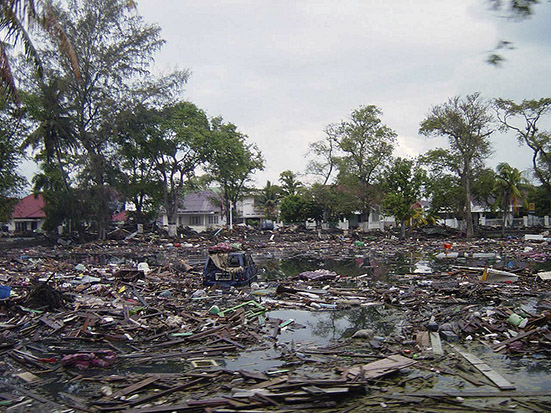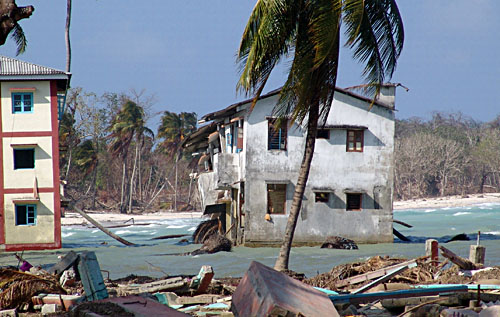Fast Facts
Tsunamis can easily knock people off their feet and float vehicles...
- 6 inches (15 centimeters) of fast-moving water can carry away an adult.
- 12 inches (30 centimeters) of fast-moving water can carry away a small car.
- 18-24 inches (45-60 centimeters) of fast-moving water can carry away most large SUVs, vans, and trucks.
Fast Facts
Tsunamis can easily knock people off their feet and float vehicles...
- 6 inches (15 centimeters) of fast-moving water can carry away an adult.
- 12 inches (30 centimeters) of fast-moving water can carry away a small car.
- 18-24 inches (45-60 centimeters) of fast-moving water can carry away most large SUVs, vans, and trucks.
Even though tsunamis do not occur very often and most are small and cause little if any damage, they are a major threat to coastal communities. Tsunamis typically cause the most severe damage and casualties very near their source.

Tsunamis with runups over one meter (3.28 feet) are particularly dangerous to people and property, but smaller tsunamis can also be dangerous. Strong currents can injure and drown swimmers and damage and destroy boats and infrastructure in harbors.

A tsunami's height and impacts at a specific coastal location are influenced by the local bathymetry and topography and the direction from which the tsunami arrives. Low-lying areas such as beaches, bays, lagoons, harbors, river mouths, and areas along rivers and streams leading to the ocean are the most vulnerable.
Large tsunamis strike with tremendous force and are a significant threat to human health, coastal property and infrastructure, coastal resources, and coastal, regional, and even national economies.
Most tsunami damage and destruction is caused by flooding, wave impacts, erosion, strong currents, and floating debris (e.g., trees, structures, vehicles, and other things that can act like battering rams). The water can be just as dangerous, if not more so, as it returns to the sea, taking debris and people with it.
The debris in the water is particularly dangerous as evidenced by bruises on the bodies of many victims of the 2004 Indian Ocean tsunami.
In addition to loss of life and mass injuries, other potential impacts include damage to and destruction of homes and businesses, ports and harbors, cultural resources, utilities, and critical infrastructure and facilities. There may be loss of access to basic services such as power, sewer, and water. Communications, transportation (ground, air, and marine), and health and public safety services may be disrupted.
Impacts from a large local tsunami will likely be in addition to impacts from a preceding earthquake, and impacts from both may trigger secondary hazards, which could be more devastating than the direct destruction.
Earthquakes and tsunamis can cause fires, transportation accidents, and hazardous material releases into the environment, contaminating water supplies and threatening public health. These impacts can further complicate evacuation, response, and recovery.

Earthquakes and tsunamis can also change the land, both above and below the water. In some places it may rise, in others it may fall. If the coast subsides (falls), flooding may be extended to unexpected areas and tsunami barriers may fail or be overtopped. Associated landslides and other sediment shifts and depositions can make waterways unnavigable.
Other potential consequences include permanent changes to beaches and other coastal features, loss of or changes to wildlife habitat, and changes to quality and availability of fresh water. Inundation by salt water, short or long term, can make agricultural land useless.
The force of the water, pollutants and toxic substances, sediment, marine debris, and invasive species can also harm agricultural land and natural resources on shore and off. Changes to these resources can affect the services they provide (e.g., biological, ecological, protective, and recreational).
Fast Facts
Tsunamis can easily knock people off their feet and float vehicles...
- 6 inches (15 centimeters) of fast-moving water can carry away an adult.
- 12 inches (30 centimeters) of fast-moving water can carry away a small car.
- 18-24 inches (45-60 centimeters) of fast-moving water can carry away most large SUVs, vans, and trucks.


